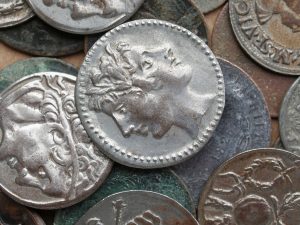[ad_1]
Pacific Money | Economy | East Asia
Systems of credit and debt are enormously consequential for trade, making the looming financial conflict between Beijing and Washington particularly worrisome.

Ongoing debate about the future of China-U.S. relations has, perhaps inevitably, reincarnated the ghost of Samuel Huntington’s “clash of civilizations,” the argument that cultural clash between “East” and “West” is inevitable, and that competition between Beijing and Washington is a manifestation of that clash. This persists despite long-standing appreciation of commercial and cultural connections between the “Confucian” world and the “West.”
Indeed, some of our modern tools of analysis can shed light on how developments on one side of Eurasia had an impact on the other side. It has long been understood, for example, that the Han Dynasty in China and the Roman Empire conducted a rigorous trade, albeit usually through Parthian intermediaries. Peter Frankopan’s recent book “The Silk Road“ challenges the idea of a stark division between East and West, pointing out the extensive commercial, social, and cultural connections between Asia and Europe even during the ancient period. Archaeological and primary source analysis also supports the idea that both Han and Roman authorities regarded the maintenance of commercial connections as a high policy priority.
A better understanding of Roman finance helps to put that trade into political and social context. The consolidation of Roman control over the Mediterranean and the transition between the Republic and the Empire led to a massive increase in trade contacts between China and Rome. While the Han Dynasty in China was more densely bureaucratized than the Roman Empire, the Roman economy appears to have been more monetized than its Chinese counterpart. Pax Romana, such that it was, provided for the existence of a “financial commons” that enabled the development of sophisticated systems of credit and finance across the empire and beyond. These systems of credit helped foster and enable the trade with the Han Empire, even if relatively few Roman coins actually made their way into Han coffers.
Why did so little coinage travel between Asia and Rome? Both the Han and Roman Empires understood the importance of managing their financial affairs, and both made efforts to control the amount of coined currency circulated through (and out of) their economies. Roman coins simply weren’t as useful to the Chinese as bullion, or the other goods that Parthian and other intermediaries could provide. Nevertheless, the fact that the Romans had established a robust system of coinage was deeply important to Chinese traders, and to the Han state. The system that developed during the late Republic and early Imperial period differed substantially from the Hellenistic period, during which the successors of Alexander established competitive, mutually antagonistic kingdoms on the ruins of the Persian Empire. These kingdoms lacked a unified coinage, preventing the establishment of systems of finance that enabled borrowing across distance and time and thus facilitated long-distance trade.
In this sense, the importance of Han-Roman trade imparts lessons for modern observers beyond the fact that China and the West have connections that reach deep into antiquity. Systems of credit and debt are enormously consequential for trade, and yet often depend precariously on the ability of hegemonic powers to establish and maintain financial stability and liquidity. This makes the looming financial conflict between Beijing and Washington look ever more ominous.
[ad_2]
Source link